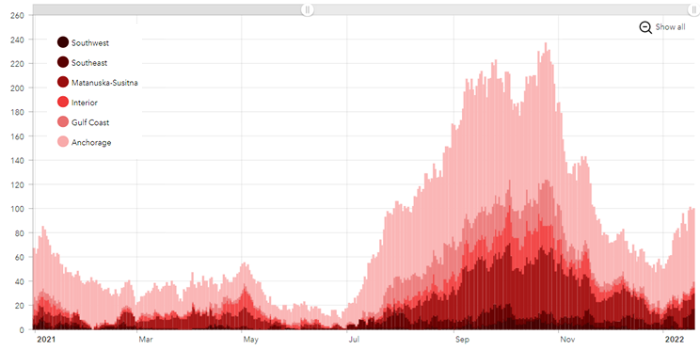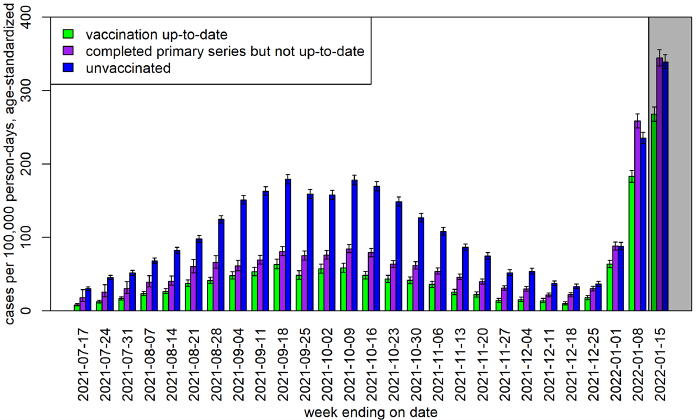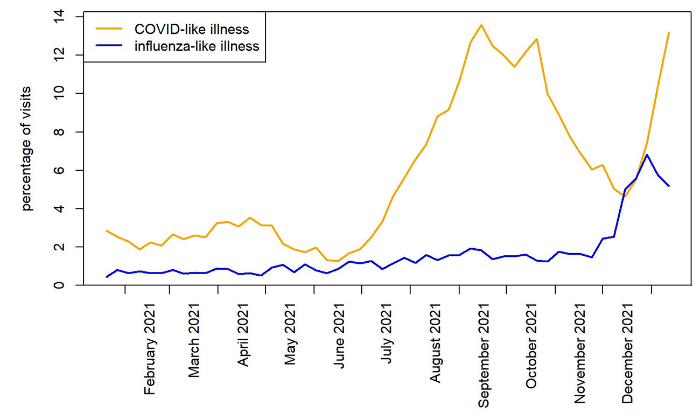|
Alaska Department of Health and Social Service Weekly COVID-19 and Influenza Update
January 9 – January 15, 2022
Key Findings
- COVID-19 cases are rising very rapidly across most of Alaska, the great majority of which are likely due to the Omicron variant.
- Appreciable levels of influenza transmission began occurring in mid-December and have continued since then.
- Other respiratory viruses are circulating in addition to SARS-CoV-2 and influenza virus.
COVID-19
COVID-19 Case Trends
- High levels of COVID-19 transmission are occurring throughout much of Alaska and the pandemic is on a rapid upward trajectory in Alaska. Hospitalizations are increasing as well.
- 15,145 cases were reported in Alaskans the week of January 9–January 15. This is a 97.4% increase from the number of cases reported the week before. This increase in cases is the largest week-over-week increase recorded in Alaska in terms of the absolute number of cases and is also among the largest in terms of the proportional increase.
- The number of reported COVID-19 cases last week was substantially higher in all 5 of the most populous boroughs compared to the previous week.
- The intensity of COVID-19 transmission varies between communities outside the largest boroughs, but many boroughs and census areas have seen recent and large increases in COVID-19 cases, and some have reached levels of weekly case counts not previously seen in the pandemic.
- Community transmission of the Omicron variant has been confirmed in multiple regions across Alaska. Laboratory evidence indicates that the Omicron variant has become the dominant SARS-CoV-2 variant in Alaska and is driving the sharp acceleration of the pandemic in Alaska. Visit Alaska’s SARS-CoV-2 Genomics Dashboard to learn more.
- To learn more about COVID-19 cases, hospitalizations, and deaths due to COVID-19 in Alaska, visit the Cases Dashboard or the monthly report. The cases dashboard includes demographic information on cases and the monthly report includes demographic information on hospitalizations and deaths.

COVID-19 cases among Alaska residents by week of onset date.
|
Borough/Census Area
|
Alert Level
December 27
|
Alert Level
January 3
|
Alert Level
January 10
|
Alert Level
January 19
|
|
Count
|
Rate
|
Count
|
Rate
|
Count
|
Rate
|
Count
|
Rate
|
|
Anchorage Municipality
|
393
|
136.0
|
2,180
|
754.4
|
4,709
|
1,629.6
|
8,330
|
2,882.7
|
|
Fairbanks North Star Borough
|
125
|
128.7
|
224
|
230.5
|
753
|
775.0
|
1,559
|
1,604.6
|
|
Juneau City and Borough
|
73
|
229.8
|
259
|
815.2
|
531
|
1,671.2
|
742
|
2,335.3
|
|
Kenai Peninsula Borough
|
78
|
132.4
|
100
|
169.7
|
266
|
451.4
|
726
|
1,231.9
|
|
Matanuska-Susitna Region
|
107
|
99.7
|
439
|
409.1
|
391
|
364.4
|
1,305
|
1,216.2
|
|
Nome Census Area
|
19
|
194.5*
|
25
|
255.9
|
165
|
1,689.0
|
279
|
2,856.0
|
|
North Slope Borough
|
6
|
61.4*
|
35
|
358.2
|
76
|
777.8
|
103
|
1,054.1
|
|
Northwest Arctic Borough
|
15
|
197.8*
|
44
|
580.2
|
86
|
1,134.1
|
191
|
2,518.8
|
|
Chugach Census Area
|
2
|
**
|
9
|
133.3*
|
33
|
488.8
|
59
|
873.9
|
|
Copper River Census Area
|
6
|
222.3*
|
7
|
259.4*
|
13
|
481.7*
|
28
|
1,037.4
|
|
Denali Borough
|
1
|
**
|
4
|
**
|
1
|
**
|
12
|
664.5*
|
|
Southeast Fairbanks Census Area
|
7
|
100.9*
|
18
|
259.5*
|
21
|
302.7
|
47
|
677.5
|
|
Yukon-Koyukuk Census Area
|
1
|
**
|
23
|
456.0
|
76
|
1,506.7
|
29
|
574.9
|
|
Haines Borough
|
0
|
**
|
32
|
1,269.8
|
38
|
1,507.9
|
36
|
1,428.6
|
|
Petersburg Borough
|
6
|
188.1*
|
5
|
**
|
6
|
188.1*
|
15
|
470.4*
|
|
Sitka City and Borough
|
29
|
340.3
|
72
|
844.8
|
160
|
1,877.3
|
154
|
1,806.9
|
|
Skagway Municipality
|
1
|
**
|
2
|
**
|
1
|
**
|
2
|
**
|
|
Wrangell City and Borough
|
1
|
**
|
2
|
**
|
27
|
1,134.9
|
55
|
2,311.9
|
|
Yakutat plus Hoonah-Angoon
|
9
|
339.9*
|
6
|
226.6*
|
19
|
717.5*
|
34
|
1,284.0
|
|
Ketchikan Gateway Borough
|
52
|
380.2
|
50
|
365.6
|
72
|
526.4
|
217
|
1,586.6
|
|
Prince of Wales-Hyder Census Area
|
7
|
114.9*
|
5
|
**
|
97
|
1,592.8
|
82
|
1,346.5
|
|
Bethel Census Area
|
18
|
100.7*
|
40
|
223.9
|
120
|
671.6
|
307
|
1,718.2
|
|
Kusilvak Census Area
|
35
|
432.7
|
17
|
210.2*
|
97
|
1,199.3
|
207
|
2,559.3
|
|
Aleutians East Borough
|
1
|
**
|
2
|
**
|
10
|
341.9*
|
27
|
923.1
|
|
Aleutians West Census Area
|
4
|
**
|
12
|
216.5*
|
72
|
1,298.7
|
204
|
3,679.7
|
|
Dillingham Census Area
|
7
|
146.7*
|
14
|
293.3*
|
26
|
544.7
|
64
|
1,340.9
|
|
Kodiak Island Borough
|
13
|
103.1*
|
57
|
452.0
|
341
|
2,704.0
|
444
|
3,520.7
|
|
Bristol Bay plus Lake and Peninsula
|
4
|
**
|
6
|
247.9*
|
17
|
702.5*
|
34
|
1,405.0
|
|
Statewide
|
1,020
|
139.9
|
3,689
|
506.1
|
8,225
|
1,128.4
|
15,305
|
2,099.7
|
Alert levels by borough and census area are based on the number of reported cases over the past 7 days per 100,000 residents.
*Rates based on <20 observations are statistically unreliable and should be used with caution.
**Rates based on <6 observations are not reported.
COVID-19 and Hospital Capacity
- Hospital capacity is currently very limited because of staff being out with COVID-19 and because of high numbers of patients.
- The Crisis Care Committee remains active seeking input from, and providing guidance to, health care providers, including allocating, augmenting, or moving constrained resources during this surge to maximize the health of all Alaskans.
- As of January 19, 2022 there were 100 persons with COVID-19 in Alaska hospitals, accounting for 10.3% of all hospitalized persons. Visit the Hospital Dashboard for more data.
Total Confirmed COVID Beds Occupied

COVID-19 and Vaccination
- 68.6% of Alaska residents aged ≥5 years have received at least one dose of a COVID-19 vaccine. Among those who completed the primary vaccine series, 45.2% of Alaska residents ≥18 years have received their booster. Learn more about COVID-19 vaccination coverage in Alaska on the Vaccine Dashboard.
- Vaccines help protect against infection and against severe disease, especially when a person is up to date on vaccinations. Unvaccinated Alaskans are more than 10 times more likely to be hospitalized due to COVID-19 than Alaskans who have completed the primary series of COVID-19 vaccination and are more than 12 times more likely to die from COVID-19. See the monthly report to learn more.
- Among Alaska residents aged ≥5 years from January 16, 2021–January 15, 2022, 40,937 cases were documented in persons who had completed the primary series and were considered fully vaccinated. Among those vaccine-breakthrough cases, 386 hospitalizations and 133 deaths due to COVID-19 have been recorded. During that time, 76,460 cases have been documented in unvaccinated Alaskans aged ≥5 years, leading to 1,677 hospitalizations and 546 deaths. All data are preliminary and subject to change.
- During the Omicron wave, cases in vaccinated persons have become more frequent, but Alaskans who are up-to-date on their COVID-19 vaccines (i.e., completed the primary series and received a booster dose, if eligible) still have lower rates of becoming a case than those who are unvaccinated or are not up-to-date.

In order to more easily identify changes over time, the definition of “up-to-date” as of January 8, 2022 was applied to data from all time points.
Influenza (“Flu”)
- Reported influenza cases began increasing in Alaska in mid-December. The number of reported cases from the week of January 9–January 15 was similar to the number the prior week.
- Right now, most influenza in Alaska is caused by influenza A.
- 23% of Alaskans aged ≥10 years have been vaccinated against seasonal influenza. It is not too late to get vaccinated against influenza.
- Last week, far more cases of influenza were reported from Anchorage than any other region. Learn more in the weekly Alaska Influenza Snapshot.

Positive influenza lab reports in Alaska by week of specimen collection for the 2017-2018 influenza season through present. The current season through January 15, 2022 is shown in red.
Emergency Department Visits with COVID-like or Influenza-like Illness
- Syndromic surveillance consists of analyzing data on symptoms and diagnoses among patients visiting emergency departments in Alaska. The main goal is to identify trends. Unlike case-based surveillance, syndromic surveillance does not depend on laboratory testing.
- Influenza-like illness (ILI) is defined as having a fever and at least one other symptom, such cough or sore throat. Patients with a diagnosis of influenza are also included, regardless of symptoms.
- COVID-like illness (CLI) encompasses a broader array of respiratory and other symptoms than influenza-like illness. This category also includes any patient with a diagnosis of COVID-19, regardless of symptoms.
- Patients with a diagnosis of COVID-19 are excluded from the ILI category and, likewise, patients with a diagnosis of influenza are excluded from the CLI category. But a patient without a diagnosis for either could be included in both the CLI and ILI categories. CLI and ILI may be caused by respiratory viruses other than SARS-CoV-2 and influenza virus.
- As the Delta variant wave waned in Alaska in late October and November 2021, the percentage of emergency department patients with CLI declined. However, it has increased over the past few weeks since mid-December and is now at a level similar to that seen at the peak of the Delta wave.
- ILI levels have been low for most of the past year but increased substantially in December. This increase corresponds to an increasing number of reported laboratory-confirmed influenza cases.

Take action to protect yourself and your family
-
Get vaccinated and stay up to date: COVID-19 vaccines are available for everyone aged 5 and older. Booster shots are available for everyone aged 12 and older if enough time has passed since the initial vaccine series. Getting vaccinated and boosted will help protect you, your family, and your community against COVID-19. Learn more about COVID-19 vaccines. You can visit vaccines.gov or text your zip code to GETVAX (438829) in English, or VACUNA (822862) for Spanish.
-
Wear a mask indoors in public: Wearing a well-fitting mask when in indoor public spaces, regardless of vaccination status, is an important step to take to slow the spread of COVID-19. Most Alaskans live in an area with substantial or high community transmission where this action is needed to protect your health and the health of others. Some masks such as surgical, KN95, or N95 masks provide higher filtration and therefore better protection than cloth face coverings, but only if the mask fits your face well and is worn consistently.
-
Practice physical distancing: When possible, avoid crowds and keep your distance from others while in public settings – particularly when indoors.
-
Get tested: Seek testing if you have any symptoms or have been exposed to an infected person. If you do test positive, isolate right away and notify your contacts. Ask your contacts to get tested at the appropriate time and, if they are not up to date on COVID vaccination, to quarantine. Learn more about COVID-19 testing.
-
Know your treatment options: If you test positive and you’re at increased risk for severe COVID, ask a health care provider about monoclonal antibody treatment or oral antivirals. These treatments reduce the risk of hospitalization. This treatment works best when given soon after symptoms start. Learn more about COVID-19 treatments.
Information and Resources
- The State of Alaska COVID-19 vaccines update page
- The State of Alaska COVID-19 information page provides more information about the virus and how individuals and businesses can protect themselves and others from transmission.
- DHSS COVID-19 Communication Toolkit provides PSAs, flyers, and social media graphics.
- Learn more about the importance of physical activity, highlighted by our Play Every Day and our Healthy You 2022 campaigns: Play Every Day.
- Subscribe to the DHSS Insights blog for behind-the-scenes news about Alaska’s COVID-19 response and other efforts to protect the health and well-being of Alaskans.
- DHSS offers free presentations upon request to groups about COVID-19, the vaccines, COVID-19 prevention, or other health topics upon request. Learn more or request a presentation on our Speaker’s Bureau web page.
- For the most up-to-date case information, see the Alaska Coronavirus Response Hub dashboard: data.coronavirus.alaska.gov. All dashboard data are updated Mondays, Wednesdays, and Fridays (except holidays).
- For DHSS media inquiries, please contact clinton.bennett@alaska.gov
ECHO sessions

Session information and recordings of previous ECHO sessions
subscribe to ECHO calendar updates | email: echo@alaskachd.org | website: akecho.org
ECHO sessions create virtual learning communities by connecting Alaska's health experts with specific audiences on specific topics. These sessions are produced and facilitated by UAA’s Center for Human Development Alaska ECHO project in partnership with the State of Alaska, Department of Health & Social Services.
Below is a selection of upcoming ECHO sessions. The full schedule of ECHO sessions and access to COVID-19 ECHO videos and slideshows are available for download anytime on the DHSS ECHO web page.
School Health ECHO
Monday, 3-4 p.m. (Register)
The School Health ECHO is a virtual learning network intended for professionals in the education setting (administrators, school-based nurses, etc.) to interface with a team of medical and education experts in Alaska.
Vaccine ECHO for Providers
Tuesday, 2-3 p.m. (Register)
The Vaccine ECHO for providers provides planning and operation updates to vaccine providers across Alaska, while answering any questions you may have.
Public Science ECHO
Wednesday, noon-1 p.m. (Register)
The Alaska Public Health Science ECHO is a virtual learning network intended for the general public to interface with our Public Health Leadership Team to explore the science of the COVID-19 virus, other public health topics, and current best practices. Or view via concurrent livestream to Facebook: https://www.facebook.com/akechoprograms
Healthcare Specific Situational Awareness ECHO
Thursday, noon-1 p.m. (Register)
The Healthcare Specific Situational ECHO is a virtual learning network intended for healthcare professionals to interface with our Public Health Leadership Team to explore current best practices and the most recent information related to Public Health.
|